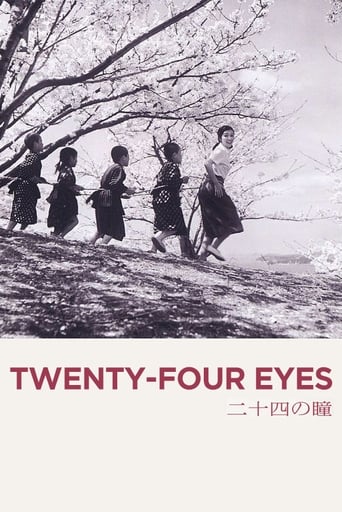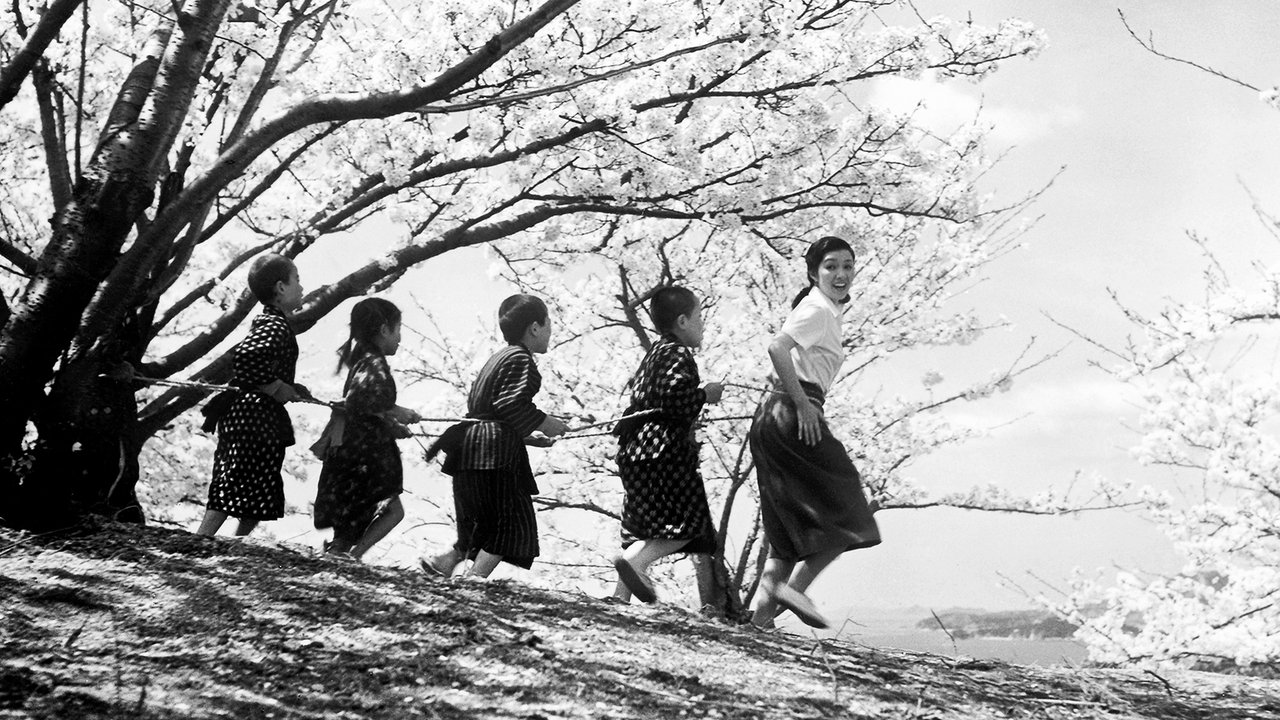thomaskasaki
25 years ago I made up my mind I would move to Japan. So I wrote to people in Japan who had lived there for over thirty years, and asked them what would be the #1 movie I should watch that encapsulated the spirit of the Japanese.They all suggested "24 Eyes". Now, after having lived in a strictly Japanese environment for five years, and having seen well over thirty Japanese movies, not to mention over a thousand hours of TV shows and animae, it is still the #1 to me. By today's standards it will seem extremely "G" rated, a little too slow and a bit too long. But for those who want to really understand people, and where they are coming from, I can't think of a better movie to recommend. I wish every culture, particularly those that may be going extinct, would use this movie as a guideline to tell their story.
gabealexander26
This film is a not-so-subtle piece of propaganda, written primarily for the people of Japan who apparently needed to wallow in the self-pity they experienced in the wake of World War II. Masterfully set around a benevolent, loving and "enlightened" teacher - who even manages to "shock" the island's inhabitants by wearing Western clothes and riding a bicycle - and her twelve original pupils, whose "twenty-four teary eyes" are constantly exploited for the manipulation of the viewer, the story does nothing to appeal to the collective sense of shame and remorse that the Japanese nation should have felt. War was treated as something of a "brutal reality" that somehow was "forced" on Japan and its inhabitants, to the point that she had to send her young men to spill their blood and give their lives heroically in the defense of the "motherland." Most infuriating was the casual mention of the "incidents" in Manchuria and Shanghai. Not even a word, if only in passing, about Nanking! Let the viewer - especially the Japanese viewer! - remember that many of the girls raped in Nanking were not much older than the teary-eyed girls shown in the film. Chinese young men fared no better as many were decapitated or buried alive for the "sport" and amusement of the Japanese butchers! This is the most shameful film in memory, one that even the Nazi propaganda machine would have had a hard time pulling off - yes, Joseph Goebbels would have been proud of it. A TOTAL WASTE OF TWO-AND-A-HALF HOURS! I will have to wash this filth from my mind tomorrow by viewing the 2007 documentary "Nanking." And, finally, a question for all those who have lavished praise for the story, the actors the director and his cinematic "accomplishment": If this story had been written in Germany in 1954 by a famous film-maker and presented to the world as a reality in that country during the years the story covered, would the movie critics' reaction be the same? Would YOUR reaction be the same? Something to think about!
Howard Schumann
Considered by some Japanese critics as one of the ten best Japanese films of all time, Keisuke Kinoshita's Twenty-Four Eyes is a moving tribute to a teacher's dedication to her students and to her progressive ideals. The film spans twenty years of turbulent Japanese history beginning in 1928 and continuing through the end of World War II. Though to Western eyes it can be at times oppressively melodramatic with its overuse of such sentimental melodies like "Annie Laurie", "Auld Lang Syne", and "Bless This House", the film was extremely popular in Japan, beating out such highly regarded classics as Mizoguchi's Sansho Dayu, Kurosawa's Seven Samurai, and Naruse's Late Chrysanthemums for Best Film in Japan and Best Foreign Film at the Golden Globes.Adapted from a novel by Sakae Tsuboi and set in the rural island of Shodoshima, the title refers to the eyes of seven girls and five boys, the twelve students of first grade teacher Hisako Oishi (Hideko Takamine), endearingly called "Miss Pebble". As the film opens, a confident new teacher, Miss Oishi, rides to the school on her bicycle dressed in modern Western clothes but soon has problems being accepted by the working class villagers who think that she is a wealthy outsider. The senior teacher (Chishu Ryu) at the primary school even asks why the authorities would send such a good teacher. Miss Oishi is also criticized for calling the students by their nicknames, inquiring into each child's family life, and singing folk songs instead of the school anthems.Later, during the Japanese invasion of China, she is suspected of being a "red" because she discourages her young pupils from becoming soldiers but does not protest when the headmaster burns one of her books. Proud but traditionally passive, she refuses to intervene in a family dispute when one of her students, a gifted singer, expresses a desire to attend the conservatory rather than go to work in a café, and does not attempt to raise funds to send one of the poorest students on a school trip. Miss Oishi is able to gain a share of acceptance, however, after an injury to her leg sidelines her for several months and the children visit her without being aware of the length of the journey. It is only when she meets the crying children on their way to her home that reconciliation with the community begins to take place.Unfortunately, the length of the trip to the school forces Miss Oishi to transfer to the middle school closer to her home and she will not teach the same children for five years. Miss Oishi is a compassionate teacher who does not want to see her bright young students killed in the war but the growing conflict in China and the increasing poverty in the village force the young men to become cannon fodder for the militarists with unfortunate results. Twenty-Four Eyes to our modern view has many excesses including its almost three-hour length but the purity and radiance of Takamine as the compassionate school teacher shines through and the film allowed Japanese audiences to experience a cathartic expression of the sadness and loss caused by the war.
Daniel Poeira
Whenever I tell someone about a Japanese movie called "24 Eyes", everyone asks me if it's a horror movie, because of the title and because of the recent boom of Japanese horror movie Hollywood remakes.I always tell them that yes, it is a horror movie. It is a movie about a woman who is dissed by an entire town because she dared to ride in a bicycle. A movie about people who actually believe that fishing is more important than music. A movie about little children who prefer to die in a war than being poor like their parents.What else could be more horrorific than all that? Black water dripping from a ceiling? A little girl walking backwards with hair covering her face?I don't think so.


 AD
AD

